Welcome to the bolt-iverse.
Join us as we explore 30 different door bolt types, and that’s without going into all of the derivatives based on:
- Variations - surface finish options, base material, backplate and fixing plates.
- Size - throw length, shoot diameter, plate width, plate length, square or radiused, plate design, handle design (knob, fish tail, curly tail, Shepherd’s crook, and more).
- Fitting - mortice, semi mortice or surface mounted, horizontally and vertically fitted.
- Bolt - round or rectangular profile bolt, straight or cranked.
- Application - internal, external, fire doors, gates.
- Security - locking options - with a secondary item (like a padlock on a padbolt) or integral locking (like a combination bolt or with allen key), or securing with a turn of the handle.
- Accessories - keeps: staple, angled, flat, inward opening, outward opening, and sockets: easy clean, dust excluding.
Instead, we cover the main types, their application, and their features. No bolt will be left behind in this guide (unless it’s for a window, then forget about it).
Table of Contents
- Barrel bolt
- Surface bolt
- Flush bolt
- French door bolt
- Combination bolt
- Monkey tail bolt
- Drop garage bolt
- Barza bolt
- Mortice door bolt
- Tower bolt
- Transom bolt
- Skeleton bolt
- Brenton bolt
- Padbolt
- Lockable surface bolt
- Pignose bolt
- Spring loaded bolt
- Cross pattern bolt
- Bow handle bolt
- Foot bolt
- Chain bolt
- Multi purpose door bolt
- Solenoid bolt
- Espagnolette bolt
- Cremone bolt
- Indicator bolt
- Deadbolt
- Latch bolt
- Hinge bolts
- Panic bolt
1. Barrel bolt

● Description: The most common type of door bolt, available in a variety of designs and finishes.
● Application: Domestic and commercial applications. Light duty use on doors and cupboards. Fit horizontally or vertically.
● Features: A circular profile bolt on a face fixed backplate. The finger grip can be rotated into the plate to lock in the thrown position.

Straight - Used on flush doors with the bolt shoot throwing into a staple keep plate.

Necked - Cranked bolts are used on inset doors with the bolt throwing into a flat fixing plate. Angled plates can be used when the bolt is near the edge of the frame.
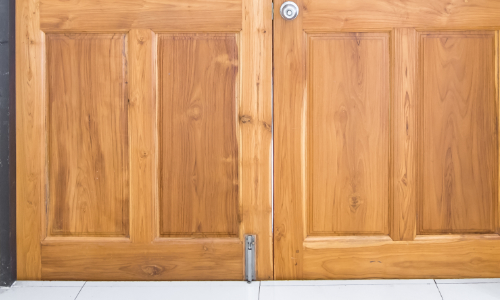
2. Surface bolt

● Description: Similar in function to a barrel bolt but has a rectangular profile bolt, not circular.
● Application: Common in residential spaces due to their aesthetics. Face fixing. Used on single, stable, and double doors.
● Features: The backplate encloses more of the bolt and has a chamfered profile.

Standard - A straight throw bolt shooting into a staple keep.

Extended - The bolt shoot projects beyond the angular body, moving the grip further from the locking point. Ideal for the top of taller doors or the bottom of doors, meaning users don’t have to bend or reach down so far to operate.

Locking - Unlike a barrel bolt, these do not rotate with the grip but lock with an Allen key.
3. Flush bolt

● Description: Morticed into the face or edge of a door, it provides a flush fitting point of locking.
● Application: Commonly installed on the leading edge of the second-opening leaf of a pair of doors. When closed, the bolt is completely concealed so is tamper-proof.
● Features: Different options for length, finish, operation, and throw, with models suitable for metal and timber doors.

Lever action - The most widely found mechanism in this type of door bolt, the up-and-over action throws the bolt into the frame.

Slide action - The bolt is thrown and withdrawn with a slide action, not lever action. The slide grip can be a small protruding knob or a sunken mechanism so they’re completely flush. These are fondly known as nail rippers as they can be a little fiddly to operate.

Anza - A flush mounted, fire rated, security bolt with concealed fixings. Tamper and abuse resistant. Also available in a surface mounted variant.

Extended throw - A standard length bolt body but the lever action throws more of the bolt shoot out, bridging wider gaps between door and frame.

Extended - Mainly used on metal doors, the hand-operated part of the bolt is fitted lower down in the door for easy operation. An internal threaded bar extends the overall length of the bolt within the body of the door.

Automatic - Sometimes handed, these bolts are automatically operated when the primary/first closing leaf closes against the latch within the bolt body, which shoots the bolt.
4. French door bolt

● Description: Available in a variety of designs, lengths, and finishes, with a standard length or extended handle for taller doors.
● Application: Pairs of external doors, fitted top and bottom for additional locking points. Used on the second closing leaf, sometimes both leaves.
● Features: A common design feature is a predominantly exposed bolt shoot with either a backplate or separate smaller fixing plates, similar to a skeleton bolt.
5. Combination bolt

● Description: A face fixing lockable bolt with slide action and staple keep.
● Application: External gates and storage areas. A basic way of controlling access without the need for physical security keys.
● Features: A locking mechanism with a varying number of combination dials, typically 3-5. Different length versions are available.
6. Monkey tail bolt

● Description: A common variant of a long handled bolt. An exposed shoot bolt is mounted to a rectangular face fixing backplate.
● Application: Tall doors and gates, often in agricultural or outbuildings like garages, barns, and sheds. Fitted to the top of doors, with a drop garage bolt at the bottom of the same leaf, although the same design of bolt can be used for both top and bottom mounting.
● Features: A long handle with a spherical knob grip, reminiscent of a monkey’s tail. Springing between the bolt and mounting plate allows for vertical mounting.

7. Drop garage bolt

● Description: A long bolt with separate mounting plates, a flat receiving plate, and a bracket.
● Application: Drop bolts are designed for installation at the bottom of gates and agricultural/industrial doors. Fitted to the internal face of the second closing leaf of a pair.
● Features: The handle used to lift and drop the bolt is at 90° to the main bolt shoot. The handle can be fully lifted and seated into the bracket which holds the bolt in the open position so it doesn’t obstruct the door or gate when in use.
8. Barza bolt

● Description: A tamper resistant straight bolt available in different lengths and materials. Operated by a large, cylindrical knob.
● Application: A versatile bolt to be used with different keep options - top and bottom mounting, inward and outward opening. Suitable for use on FD30 fire rated doors, and can be horizontally or vertically mounted. Barza bolts are perfect for public areas.
● Features: A high security bolt with fully concealed fixings. Locking and non-locking options are available. It can only be removed from the door with a Barza removal tool.
9. Mortice door bolt

● Description: Also known as rack bolts, they provide secondary, additional security. Security door bolts are mortice fitting. Standard 32mm backset with extended versions available.
● Application: Fit top and bottom to external residential doors or they’re used to secure the two halves of a stable door together, with shorter versions available for windows.
● Features: Operated by a star or spline key (standard or extended length), supplied with a small escutcheon and keep plate. They can also be operated by a thumbturn knob.
10. Tower bolt

● Description: An agricultural, outdoor bolt with face fixing backplate and staple keep.
● Application: External use to hold gates or doors in the closed position. Cranked version available. For horizontal fitting.
● Features: Popular finishes are black, galvanised, and bright zinc plate to match other gate hardware.
11. Transom bolt

● Description: A long, pivoting bolt that is concealed once fitted.
● Application: Install in the head of the door frame on pairs of doors.
● Features: Supplied with flat and bevelled strike plates for the top of the door leaves. Allows for near-simultaneous opening of double doors.
12. Skeleton bolt

● Description: A straight shoot bolt available from short (150mm) to long (600mm+) lengths.
● Application: A decorative option for horizontal and vertical installation to single and double doors.
● Features: An exposed shoot with decorative fixing brackets.
13. Brenton bolt

● Description: A robust bolt with a hooked handle and ringed backplate provides a padlock securing point.
● Application: External gates and doors to outbuildings. Horizontal and vertical installation.
● Features: Face and bolt fixing holes for additional security.
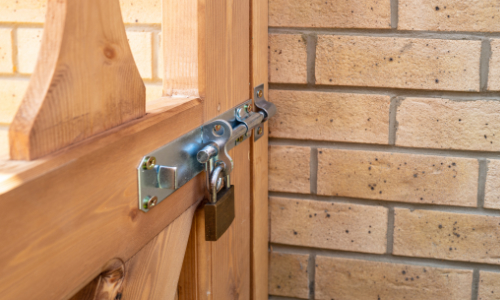
14. Padbolt

● Description: A smaller, oval pattern version of a Brenton bolt.
● Application: External gates and doors.
● Features: The ‘T’ shape handle secures the bolt in place once thrown and a padlock can be fixed through the loops. Bolt fixing holes provide a robust fixing.
15. Lockable surface bolt

● Description: A long handled bolt, similar to a drop garage/cane bolt, but can be secured with a padlock.
● Application: External gates and large doors.
● Features: Integral hasp and staple. Face and bolt fixing holes for additional security.
16. Pignose bolt

● Description: Also known as an auto-locking pig bolt. A straight sliding bolt similar to a tower bolt.
● Application: Gates and doors in areas where animals are kept.
● Features: A security guard covers part of the mechanism which prevents it from being operated by the more dexterous parts of an animal, such as a pig’s nose.
17. Spring loaded bolt

● Description: An ‘L’ shaped bolt on a face fixing backplate with an integral spring.
● Application: External gates and doors.
● Features: The spring and molded bracket allow for the bolt to be held in the open position, allowing for ease of use and a free flow of traffic.
18. Cross pattern bolt

● Description: A cross shaped bolt, very similar to a lockable surface bolt.
● Application: External gates and doors.
● Features: Integral hasp and staple. Face and bolt fixing holes for additional security.
19. Bow handle bolt

● Description: Also known as a loop handle bolt, it’s similar to a monkey tail bolt but with a rounded grip.
● Application: Tall doors and gates. Fitted to the top of doors, with a drop garage bolt at the bottom of the same leaf, although the same bolt can be used for both top and bottom mounting.
● Features: A looped handle for easy grip.
20. Foot bolt

● Description: Similar to a foot operated door holder but with a straight shooting bolt, not a rubber buffer.
● Application: The base of a door or gate.
● Features: Operation and release using foot operated controls on the body of the bolt.
21. Chain bolt

● Description: A long handled bolt that is retracted using a long chain rather than a fixed handle.
● Application: Fitted to the top of a door or gate.
● Features: Guides allow the chain to hang in line with the bolt, preventing it from getting tangled or caught on any obstacles.
22. Multi purpose door bolt

● Description: A silver finish straight sliding shoot bolt available with a different coloured body.
● Application: A versatile bolt for side hung doors, gates, sliding doors, French doors, and garages.
● Features: A key-locking function for controlled access and security.
23. Solenoid bolt

● Description: A type of electric lock, with a small protruding bolt.
● Application: Morticed horizontally or vertically into single or double swing doors. Models available to suit fire doors, glass doors, and external doors. For use as part of an access control system.
● Features: Products available with fail safe or fail secure operation, with door monitoring.
24. Espagnolette bolt

● Description: A type of mortice door lock that features multiple types of bolts.
● Application: External entrance doors, often residential front and rear doors.
● Features: Multiple locking points. Models available that are operated by a cylinder lock barrel, handle, or turn.
While this is called a bolt, it’s something those of us in the trade would class as more of a door lock than a door bolt. Head over to our comprehensive guide to door locks to find out more.
25. Cremone bolt

● Description: A surface mounted version of the above espagnolette lock.
● Application: The internal face of external doors, often pairs of doors.
● Features: Top and bottom shooting bolts, commonly operated by an integral door knob or lever handle.
Again, this is more of a complete door lock but does feature bolts.
26. Indicator bolt

● Description: Also called a privacy bolt, this is a turn operated straight shooting bolt.
● Application: Surface mounted to thin doors such as toilet cubicles.
● Features: An external indicator that could show Vacant/Engaged text or be red/white or red/green to show occupancy.

27. Deadbolt

● Description: A single bolt that is part of a larger lockcase.
● Application: Internal and external doors.
● Features: Deadbolts can be straight sliding, claw, or hook, and operated by a key or cylinder lock barrel.
28. Latch bolt

● Description: A straight shooting bevelled latch bolt found alone or as part of all sorts of locks including digital locks.
● Application: Internal and external doors, cupboards, and storage. Can be morticed or surface mounted as part of a nightlatch or rim lock.
● Features: Retracted by a door handle or door knob. Sprung loaded so automatically returns to the extended position after use.
29. Hinge bolts

● Description: A pair of bolts that are morticed into the frame of a side hung door on the hinge side.
● Application: Outward opening external doors. One pair per door.
● Features: Protruding bolts with receiving plates for additional security on external doors that could be subject to vandalism or abuse, or where there is a risk of break in.
Perhaps not strictly a door bolt but it is an item of secondary security that is fitted to the door and is called a “bolt”, so it made the cut!
30. Panic bolt

● Description: An item of panic hardware for use in emergency situations. Operated by a long push bar or smaller push pad.
● Application: The internal face of single and double external doors.
● Features: Straight shooting bolts that are retracted by a single push or touch action. Can also feature a latch bolt and have external access through a separate OAD (outside access device).
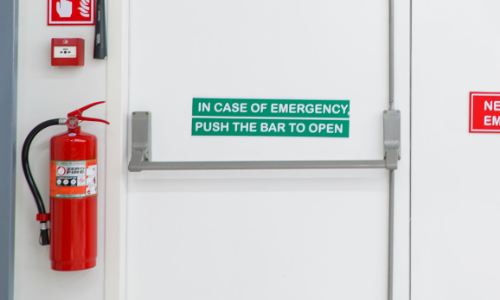
Don’t bolt just yet
Was that too many bolts? Never.
From straight barrel bolts and familiar lever action flush bolts to the less common range of agricultural bolts, through to multipoint locks and panic hardware, we’ve covered enough different types of door bolts to satisfy the curiosity of even the most inquisitive of tradespeople.
There is a surface or flush bolt for every project, every facility, every door, every gate, everything. But if you need some help navigating to the right item of door hardware for your application, please get in touch today:
T: 01305 263300
E: sales@doorcontrolsdirect.co.uk
Our customer service team is on hand to help with product selection, installation queries, and troubleshooting so don’t hesitate to reach out.

















































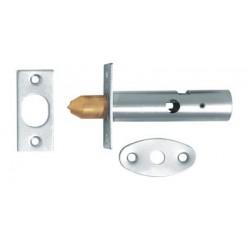
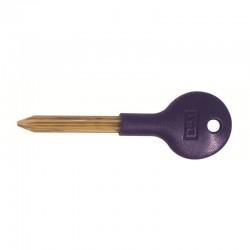
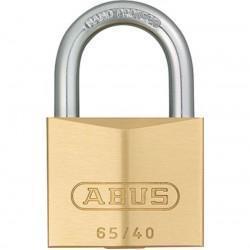
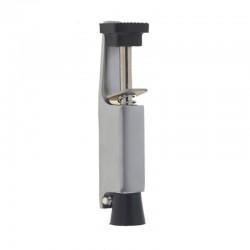

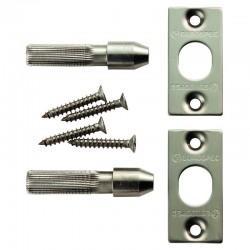
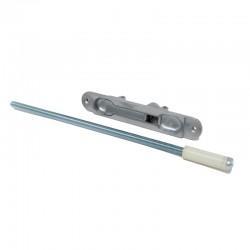
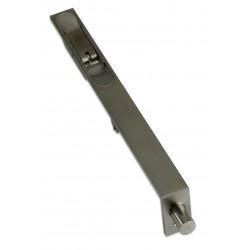
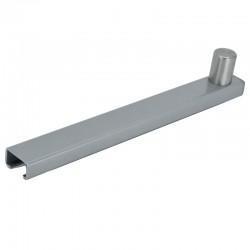


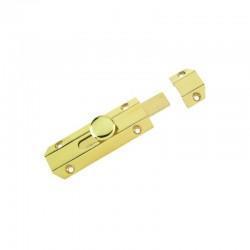
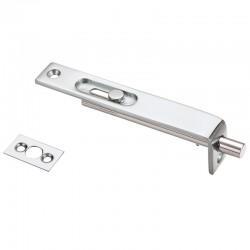
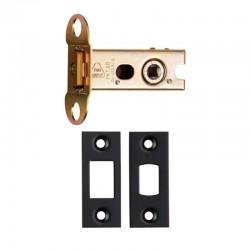
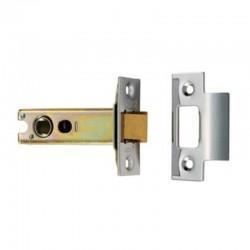
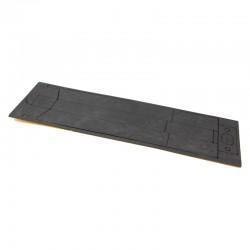

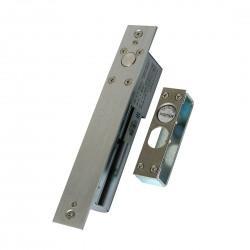
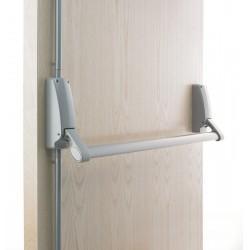
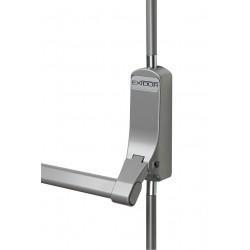
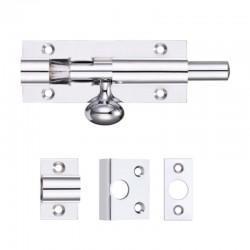
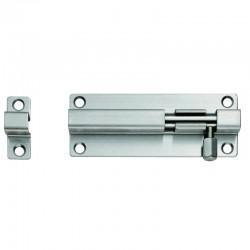
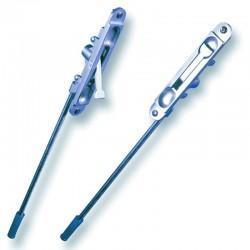





Comments